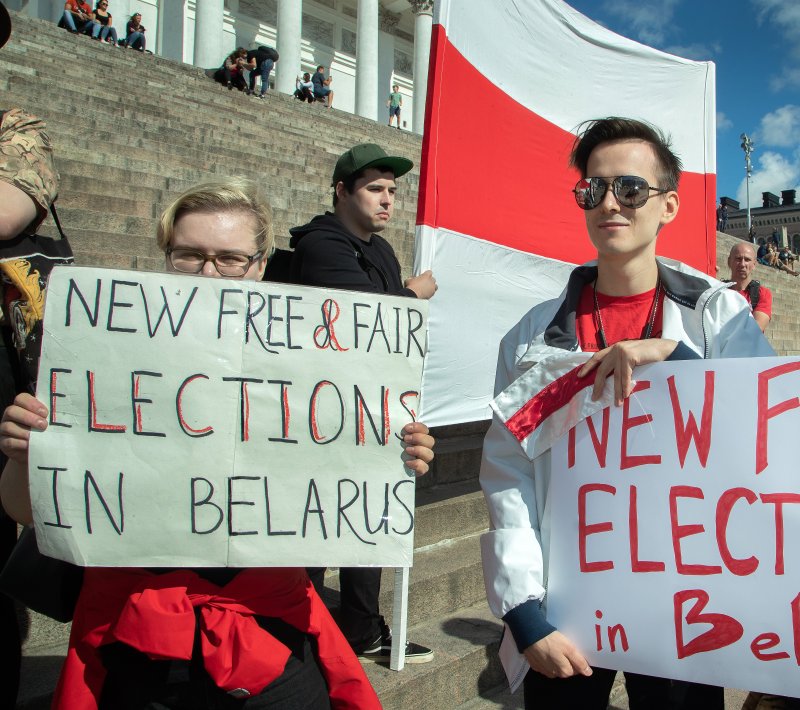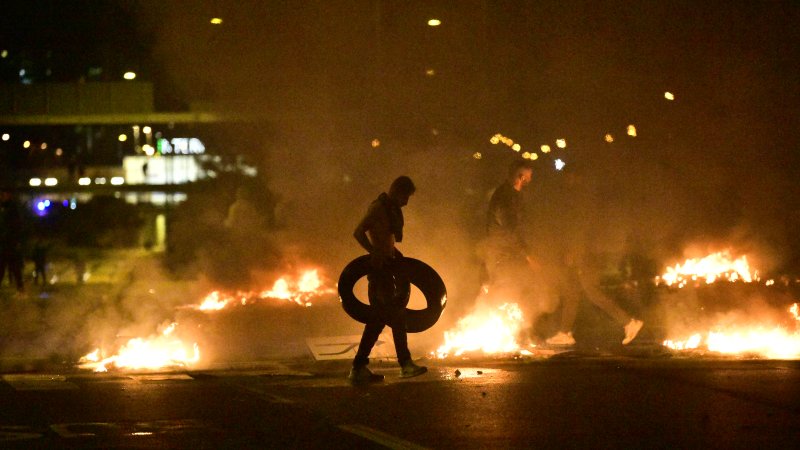All migrants moved off Banksy-funded rescue vessel stranded in Mediterranean
Issued on: 30/08/2020 -

The Louise Michel rescue vessel with people rescued on board after operations in the Mediterranean, 70 miles southwest Malta on August 29, 2020. © Santi Palacios, AP Photo
All of the migrants on board a rescue ship funded by British street artist Banksy have been transferred to other vessels, the team behind the mission said after their pink-and-white ship carrying more than 200 passengers sent an urgent call for help.
An Italian patrol vessel rushed to the stranded MV Louise Michel in the Mediterranean and took in 49 of the most vulnerable people on Saturday, the coastguard said.
The remaining migrants on board, around 150 people, were received by a vessel chartered by German NGO Sea Watch and medical charity Doctors Without Borders (MSF), according to tweets from both organisations and the Louise Michel's crew.
"For those most recently embarked, medical assessment is ongoing, with the clinic full & #MSF medics treating people for fuel burns, dehydration, hypothermia & traumatic injuries," the MSF Sea Twitter account said of the situation on board the Sea-Watch 4.
The German-flagged Louise Michel had said it needed aid after helping a boat carrying at least one dead migrant in the sea that divides Africa and Europe.
#LouiseMichel just transferred all remaining guests onto #SeaWatch4, who now have about 350 people on board. It's not over: We demand a Place of Safety for all survivors, now. pic.twitter.com/KjUEG6yp4A— LouiseMichel (@MVLouiseMichel) August 29, 2020
Its crew said the 31-metre (101-foot) ship had become overcrowded and unable to move, warning that some of the migrants had fuel burns and had been at sea for days.
"Given the danger of the situation, the coastguard sent a patrol boat to Lampedusa which took in 49 people deemed the most fragile, including 32 women, 13 children and four men," said a coastguard statement.

New Banksy-funded migrant rescue ship weathers 'very dramatic moment' in Mediterranean
160000
The rescued migrants later said three people had died at sea before the arrival of the Louise Michel.
Banksy, who keeps his identity a secret, explained in an online video that he had bought the boat to help migrants "because EU authorities deliberately ignore distress calls from non-Europeans".
'Lack of reaction'
Sea-Watch 4, which has a clinic on board and is itself in search of a host port, said it was now carrying 350 people after sailing for four hours to help the Louise Michel.
Its crew decided to take action "in the face of the lack of reaction" from the authorities, a Sea Watch spokesman told AFP.
The #SeaWatch4 has completed the transshipment of about 150 people rescued in recent days by the #LouiseMichel.
We now have ~350 people on board who need to disembark in a safe port as soon as possible.#DefendSolidarity pic.twitter.com/ZIMGkwBlGi— Sea-Watch International (@seawatch_intl) August 29, 2020
The Louise Michel vessel's crew of 10 had already rescued 89 people from a rubber boat in distress on Thursday.
They had tweeted that there were a total 219 people on board and that they had requested assistance from both the Italian and Maltese authorities.
The boat -- a former French customs vessel named after 19th-century French anarchist Louise Michel -- was around 90 kilometres (55 miles) southeast of Lampedusa on Saturday, according to the global ship tracking website Marine Traffic.
It features a Banksy artwork depicting a girl in a life vest holding a heart-shaped safety buoy.
Its crew is "made up of European activists with long experience in search and rescue operations" and is captained by German human rights activist Pia Klemp, who has also captained other such rescue vessels, The Guardian newspaper reported.
Thousands of people are thought to have died making the dangerous trip across the Mediterranean to flee conflict, repression and poverty in Africa and the Middle East.
According to the UN refugee agency, UNHCR, attempts by migrant boats to cross the Mediterranean into Europe have increased this year, up 91 percent from January to July over last year's figures, to 14,481 people.
'Anti-fascist fight'
Banksy's involvement in the rescue mission goes back to September 2019 when he sent Klemp an email asking how he could contribute.
Klemp, who initially thought it was a joke, told the paper she believed she was chosen because of her political stance, The Guardian said."I don't see sea rescue as a humanitarian action, but as part of an anti-fascist fight," she told the paper.
This month, humanitarian organisations said they would resume migrant rescues in the Mediterranean Sea, where none have operated since the rescue ship Ocean Viking docked in Italy in early July.
Before the Ocean Viking's last mission, rescue operations in the Mediterranean had been suspended for months because of the coronavirus pandemic.
Meanwhile in the French port city of Marseille, 30 protesters called on Italian authorities to release the Ocean Viking, which was detained by the Italian coastguard over technical irregularities.
(AFP)









